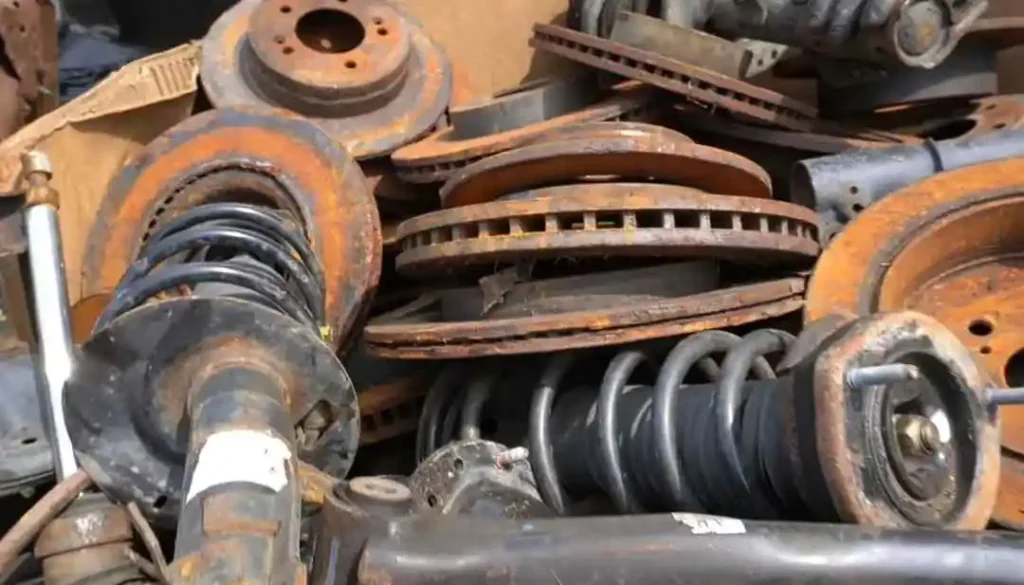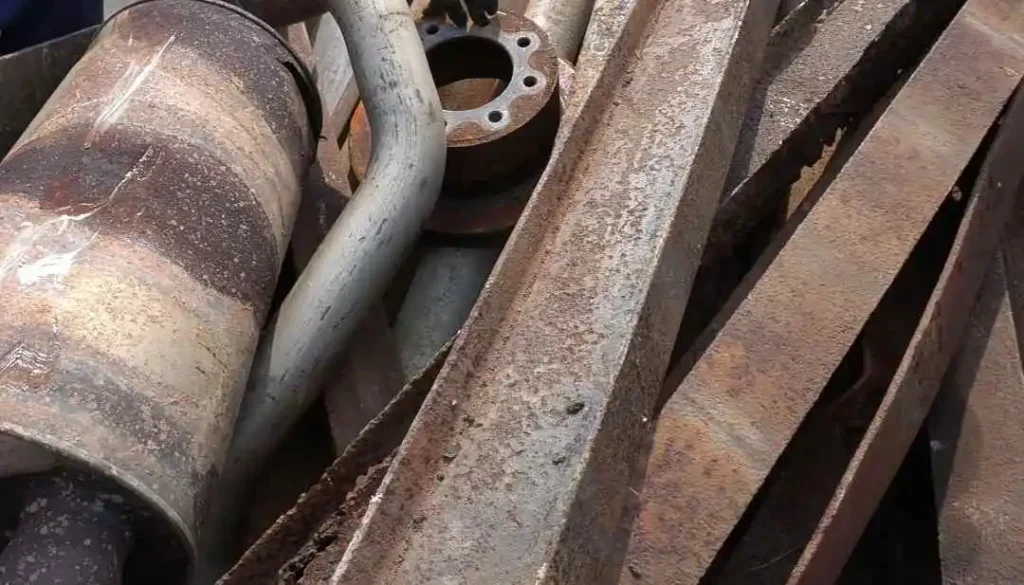Scrap Iron Prices Per Kg
The scrap iron prices per kilogram range between £ 0.16 – 0.26 Per Kg, £ 0.15 – 0.23 Per Kg, washing machine scrap prices £ 0.15 – 0.23 Per Kg, and refrigerator scrap prices £ 0.13 – 0.21 Per Kg. These prices are based on the demand and supply of scrap iron. The scrap iron prices per kg are affected by economic conditions, market trends, currency exchange rates, transportation costs, and competition among scrap yards. Clean and well-sorted iron scrap is more desirable and has good prices. A mixture of different metals in white goods prices will be based on its material type. The prices given below belong to iron scrap.
Metals
Prices Per Kg
| Iron Scrap | £ 0.16 – 0.26 Per Kg |
| Mix Iron | £ 0.15 – 0.23 Per Kg |
| Washing Machine | £ 0.15 – 0.23 Per Kg |
| Refrigerator | £ 0.13 – 0.21 Per Kg |
| Dryers | £ 0.16 – 0.25 Per Kg |
| Microwaves | £ 0.17 – 0.29 Per Kg |
Scrap Iron Prices
Scrap iron prices currently ranging between £ 0.16 – 0.26 Per Kilogram and mix iron ranging between £ 0.15 – 0.23 Per Kilogram. Iron scrap is the most valuable item in the recycling industry. Iron is widely used in different industries due to its durability and strength. The recycling of iron reduces the mining of ore extraction. It is also a cost-saving technique that helps to boost the economy of the country. It plays a crucial role in preserving national resources. Iron scrap produced from different sources like the end of machinery, home appliances, end vehicles or accidental vehicles, end ships, end airplanes, and industry heavy machinery is the major source of iron scrap. There are several types of iron scrap: heavy melting scrap (HMS), light melting scrap (LMS), shredded scrap, cast iron scrap, and railroad iron scrap.
Iron Scrap
£ 0.16 – 0.26 Per Kg
Mix Iron
£ 0.15 – 0.23 Per Kg

Mix Iron Scrap Metal Prices

Iron Scrap Metal Prices
Iron Scrap
Scrap iron prices currently range between £ 0.16 – 0.26 Per Kilogram. However, scrap iron prices vary from city to city; you can see prices of scrap in different cities in the United Kingdom.
Mix Iron Scrap
The scrap iron prices of mix iron scrap currently range between £ 0.15 – 0.23 Per Kilogram.
Washing Machine Scrap
The scrap iron prices of washing scrap range between £ 0.15 – 0.23 Per Kilogram.
Refrigerator Scrap
The scrap iron prices of refrigerator scrap range between £ 0.13 – 0.21 Per Kilogram.
Dryers Scrap
The scrap iron prices of dryers scrap range between £ 0.16 – 0.25 Per Kilogram.
Microwaves Scrap
The scrap iron prices of microwaves scrap range between £ 0.17 – 0.29 Per Kilogram.
Types of Iron
There are different types of iron with unique properties and suitable for various industries. Some types of iron with its properties are given below:-
Cast Iron
Cast iron with high carbon content making it hard and brittle. Cast iron has excellent heat retention properties, making it suitable for cooking applications. It is frequently used in casting and producing different types of items like engine blocks, pipes, and various industrial components.
Steel
The uses of steel are versatile, and a wide range of applications are made of steel. These properties make it the most widely used material in the world. Steel is an alloy of iron with carbon and other elements, giving it additional properties and versatile uses. Here, some types of steel are given, such as carbon steel and stainless steel, with unique properties of added strength, heat resistance, and corrosion resistance.
Wrought Iron
Wrought iron is known for its low carbon content. It is historically a form of iron. It has been used in decorative items and structural components.
Alloy Iron
Alloy iron is a form of various alloys with iron. It produces specific types of iron and enhances the properties of iron. The combination of iron with other elements enhances certain properties. Various alloys such as nickel and chromium containing iron are used to improve properties such as corrosion resistance and strength and heat resistance.
Pig Iron
Pig iron is known for its high carbon content. It is obtained by smelting iron ore in a blast furnace. Pig iron is an intermediate product in the iron and steel production process. It is also used for steel production, the foundry and casting industry, the manufacturing of iron and steel products, and alloy production.
Ductile Iron or Nodular Cast Iron
This form of cast iron is known as nodular cast iron. It is suitable for applications where strength and flexibility are essential. Ductile iron is commonly used in automotive components, pipes, and some other applications.
Malleable Iron
This is another type of cast iron that undergoes heat treatment to enhance its malleability and ductility. These properties allow this type of iron to shape or bend without breaking.
Welded Iron
Welded iron refers to iron or steel that has undergone a welding process to join different pieces together. It can be welded structures and pipes.
The Recycling Process of Iron Scrap
The recycling process of iron scrap is eco-friendly and reduces mining. The recycling process of iron scrap is based on the following steps:-
Production of Iron
The primary source of iron ore is extracting iron ore from mines and processing it to obtain usable iron ore. The secondary resource is the recycling of iron scrap. Finally, this usable iron is used in the manufacturing industry to make iron and steel products. This production process is a major component of the global iron and steel industry, supporting economic development worldwide. Iron is the most used material in the world. It helps us to build strong structures building and automobiles.
Discovery of Iron Ores & Mining Process
Ore mines are special places where we find the world’s most important metals. Geologists and geophysicists study the Earth’s crust to find areas where ore deposits may be hidden. It is like embarking on a quest to find the perfect spot where nature has hidden its iron treasures. After the mining area is identified, the miners swing into action. They also use various types of methods to extract iron ore from the Earth. It starts with digging deep tunnels with the help of heavy mining machinery. It helps bring the iron ore rocks up to the surface.
Types of Iron Ore
These varieties have their own unique qualities. The miners carefully choose which type to extract based on what is most useful in different applications. There are two main types of iron ore given below:-
a. Hematite
b. Magnetite
Crushing and Cleaning
After mining, we need to crush the iron core into tiny pieces, making it easier to work with. Then, we give it a good cleaning to get rid of any dirt or unwanted particles.
Furnace Process
A furnace is a high-temperature machine that melts metals and helps separate other impurities. In this process, we load iron cores with a mixture of coke and limestone, and we get molten iron, then, we can use this molten iron in molds, bars, and various shapes.
Distribution to Manufacturing Units
After the production of iron ore from processing units, this iron ore is ready to be supplied to various manufacturing industries like the automobile industry, steel industry, construction industry, etc. Distribution can be by ships, trucks, and rail. Distribution by rail is much cheaper than others.
Conclusion
Scrap iron prices per kilogram are influenced by a variety of factors such as demand, supply, economic conditions, market trends, currency exchange rates, transportation costs, and competition among scrap yards. The prices provided for different types of iron scrap reflect the current market conditions, with clean and well-sorted iron scrap generally fetching higher prices.
The recycling process of iron scrap is highlighted as an eco-friendly method that not only reduces the need for ore extraction but also plays a significant role in preserving national resources. The process involves the collection, sorting, shredding, cleaning, melting, and casting of iron scrap, ultimately contributing to the production of usable iron for various industries.
Different types of iron, including cast iron, steel, wrought iron, alloy iron, pig iron, ductile iron, malleable iron, and welded iron, have unique properties and applications in various industries. The recycling process ensures that these types of iron can be reused efficiently.
The discovery of iron ores and the mining process are briefly described, emphasizing the importance of geologists and geophysicists in identifying ore deposits. Two main types of iron ore, hematite and magnetite, are mentioned, and the subsequent processes of crushing, cleaning, and furnace processing are outlined. The final step involves the distribution of the produced iron ore to manufacturing units through various means such as ships, trucks, and rail, with rail distribution being highlighted as a cost-effective option.
Overall, the scrap iron industry not only provides economic benefits but also contributes to environmental sustainability through the efficient recycling of iron resources. It plays a crucial role in meeting the demands of various industries and supporting economic development on a global scale.
